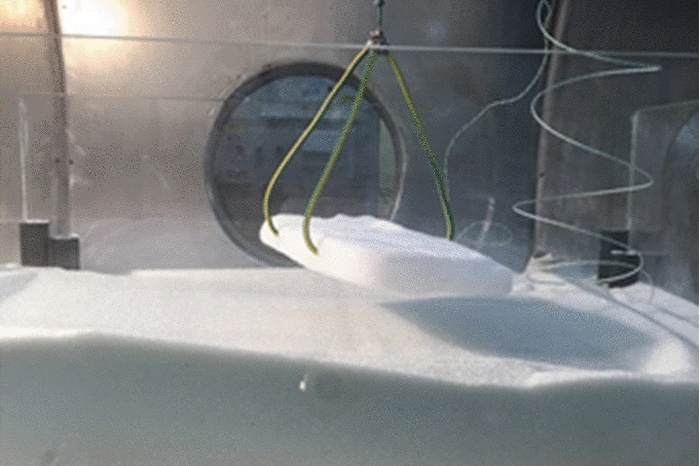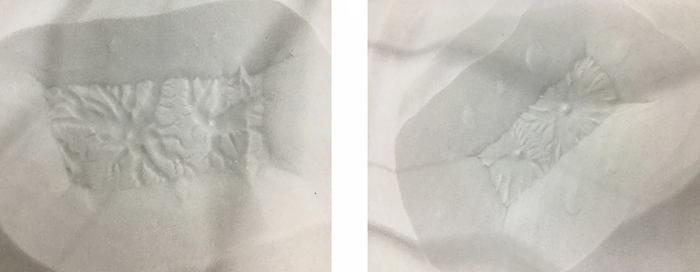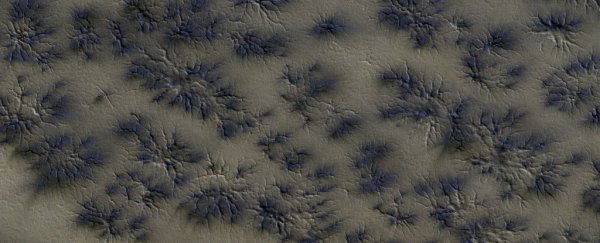We may not have detected life on Mars, but we have found 'spiders'… of a sort.
They're called araneiforms: dark, spider-like systems of branching, fractal troughs found only in the southern polar regions of the red planet. There's nothing like them on Earth, or any other planet in the Solar System.
That makes it tricky to understand what creates them, but scientists have just obtained the first physical evidence that supports the most popular model, known as Kieffer's hypothesis. According to this idea, the spider-like forms are shaped by the direct sublimation of frozen carbon dioxide (CO2).
"This research presents the first set of empirical evidence for a surface process that is thought to modify the polar landscape on Mars," said planetary scientist Lauren McKeown, formerly of Trinity College Dublin in Ireland, and now at Open University.
"Kieffer's hypothesis has been well accepted for over a decade, but until now, it has been framed in a purely theoretical context. The experiments show directly that the spider patterns we observe on Mars from orbit can be carved by the direct conversion of dry ice from solid to gas."
Mars is both quite similar to, and very different from, Earth. Its axial tilt is very close to Earth's, which means its seasonal temperature variations are a lot like Earth's, too (even though the year, and therefore the seasons, are twice as long on Mars). That means significant drops in temperature in fall and winter, and an upward rise again in spring and summer.
The Martian atmosphere, on the other hand, is very different from Earth's atmosphere; it's much thinner, and made up mostly (around 95 percent) of carbon dioxide. The planet is also much farther than Earth from the Sun, so it's much colder there. When winter falls, carbon dioxide from the atmosphere freezes on the ground, particularly at higher latitudes.
In 2006 and 2007, geophysicist Hugh Kieffer and colleagues proposed that, in spring, this frozen carbon dioxide sublimates - that is, it transitions from an ice to a gas, without the melting-to-liquid step in between - trapped beneath translucent slabs of surface ice.
As the gas warms and expands, pressure builds until the slab cracks, creating a vent for the gas to escape. While flowing towards the vent, the gas carves out a spider-like system of channels in the Martian surface, carrying the excavated material with it.
Together, the gas and material are ejected as a high-velocity jet. When the slab of ice on top finally melts, what is left is the araneiform.
This hypothetical process, Kieffer noted, is unlike anything observed on Earth; it's also never been observed on Mars - we've only seen araneiforms in satellite imagery - so McKeown and her team designed an experiment to replicate the process in a laboratory setting.
They made use of a phenomenon you can observe in your kitchen, called the Leidenfrost effect: If a droplet of water is placed on a surface significantly hotter than the water's vaporization point, the droplet will levitate (that's why water in a very hot frying pan will dance about like mercury).
 Lowering a CO2 ice slab onto the glass sand. (McKeown et al., Sci Rep, 2021)
Lowering a CO2 ice slab onto the glass sand. (McKeown et al., Sci Rep, 2021)
In a special chamber with pressure lowered to Mars's atmosphere, the team placed a slab of CO2 ice with a single hole drilled through on a surface covered in tiny grains of glass that simulated dirt, or regolith.
When the ice touched the surface, it started to sublimate, seen in the form of gas escaping the hole. Once the team lifted the ice, they found a spider-like fractal system of channels carved in the glass sand where the gas had flowed across it to escape through the hole.
In fact, the process was so vigorous, material was thrown all over the chamber, suggesting that sublimation rates on Mars can be an order of magnitude higher than those on Earth.
 The resulting pattern. (McKeown et al., Sci Rep, 2021)
The resulting pattern. (McKeown et al., Sci Rep, 2021)
The team repeated the experiment with differently sized grains to observe how different regolith textures affect the outcome. They found that the finer the grain size, the more branched the pattern.
More than that, though, the experiment is the first time scientists have actually demonstrated that Kieffer's hypothesized process can indeed happen - and is a significant weight in its favor as pertains to the araneiforms on Mars.
The results suggest that geomorphic processes on Mars still have a few secrets up their sleeves, and also that carbon dioxide sublimation may be an explanation for other strange surface features on Mars.
The team hopes that studying araneiforms over multiple Mars years could help shed more light on the planet's fascinating seasonal processes.
The research has been published in Scientific Reports.
